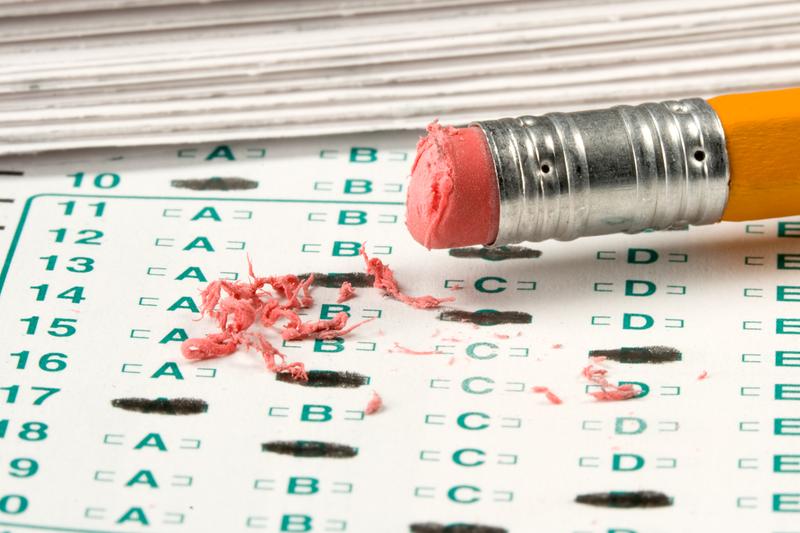
Students in New Jersey no longer need No. 2 pencils for state tests. Bubbling in answers on a scantron is now a thing of the past.
Beginning in the third grade students will be typing up timed essays and entering math answers on a computer or tablet for the state’s new standardized test, called the PARCC. It’s administered online.
In the six-building school district of Verona, N.J., which has just 2,250 students, extending Wi-Fi and buying enough computers for every student to take the online test cost the district $800,000.
“We did have to hit the taxpayer and issue a bond and borrow money,” said John Quattrocchi, the president of the Verona school board.
He said preparing for the PARCC has been a scramble for even his small school district.
The PARCC tests higher standards than the previous exam, called the NJASK.
Math taught in the 9th grade, for example, is now taught in 7th grade. It’s based on national curriculum called Common Core that the state has been gradually implementing over the past few years.
“We feel confident that we’re as Common Core compliant ready as it can get at this stage of the game,” Quattrocchi said. “What we’re very uncomfortable with is, having never seen the test itself, how accurately it’s going to be a reflection on our understanding and interpretation of Common Core.
Amid criticism, the state announced in July that test results will account for 10 percent of teacher evaluations, instead of the planned 30 percent.
Now a bill in the legislature seeks to delay test results from factoring into teacher evaluations for the first three years of the new test. It would also block test results from determining student placements, such as an honors program.
Across the state, opponents of the PARCC are encouraging parents to pull their children out of testing.
Inside the PARCC
The PARCC demands more critical thinking than the previous state exam, called the NJASK. (Click here for a sample 4th grade NJASK language arts test).
Questions can have more than one correct answer, but students will be expected to the select the answer that is the most correct. And in both math and language arts exams students will be asked to explain how they arrived at their responses.
“Have you tried the PARCC test?,” asked Verona parent Beth O'Donnell-Fischer. “That’s the clearest way to explain it.” (Click here for a sample 4th PARCC language arts test).
The mom of three took some of the practice tests online and thinks it is too abstract for young children.
“It’s impossible for adults to understand even what the questions are looking for,” she said. “And we’re talking about 3rd, 4th, 5th grade tests. Not even the high school tests.”
She has pulled her daughters from taking the PARCC and participating in any test-prep. She made the decision after her 10-year-old, Wednesday, had a break down during a practice test in the fall.
“We were just doing prep for it,” said Wednesday. “But I took an example online and I just started to cry.”
The math portion consists of more word problems under the PARCC, and that’s a problem for Wednesday.
“Since I’m dyslexic it was really confusing for me because I like mix up words, so if I mix up any words it will completely change the whole thing.”
Her mom decided to homeschool Wednesday after that. Her other daughters, Kitty and Tigerlily are still in school. They’ll be among two dozen students in Verona reading a book in the exam room while others take the test.
Both are good students who have performed well on standardized tests in the past. Frank Belluscio with the New Jersey School Board’s Association says they’re fairly representative of the types of students whose parents have opted out of taking the test.
“We have seen it in some of our wealthier communities,” he said. “In terms of middle income communities, we have not heard as much of a movement.”
Belluscio said there was similar anxiety about the NJASK when it was introduced. But he believes teachers and parents will ultimately come to like the PARCC test better.
“It is more specific,” he said. “A teacher looking at PARCC results will be able to tell if a child is having difficulty with multiplication and division, for instance. Whereas the previous test they could not really pinpoint where help is needed.”
Parents who opt out might be causing a problem for their local school district.
The federal government requires 95 percent of students in grades 3 through 8 to take the test, according to the New Jersey Department of Education. It sent a letter to districts in October reminding them that schools that don't meet the participation requirement could lose federal funding.
New Jersey receives $330 million in Title I funding from the federal government each year.
